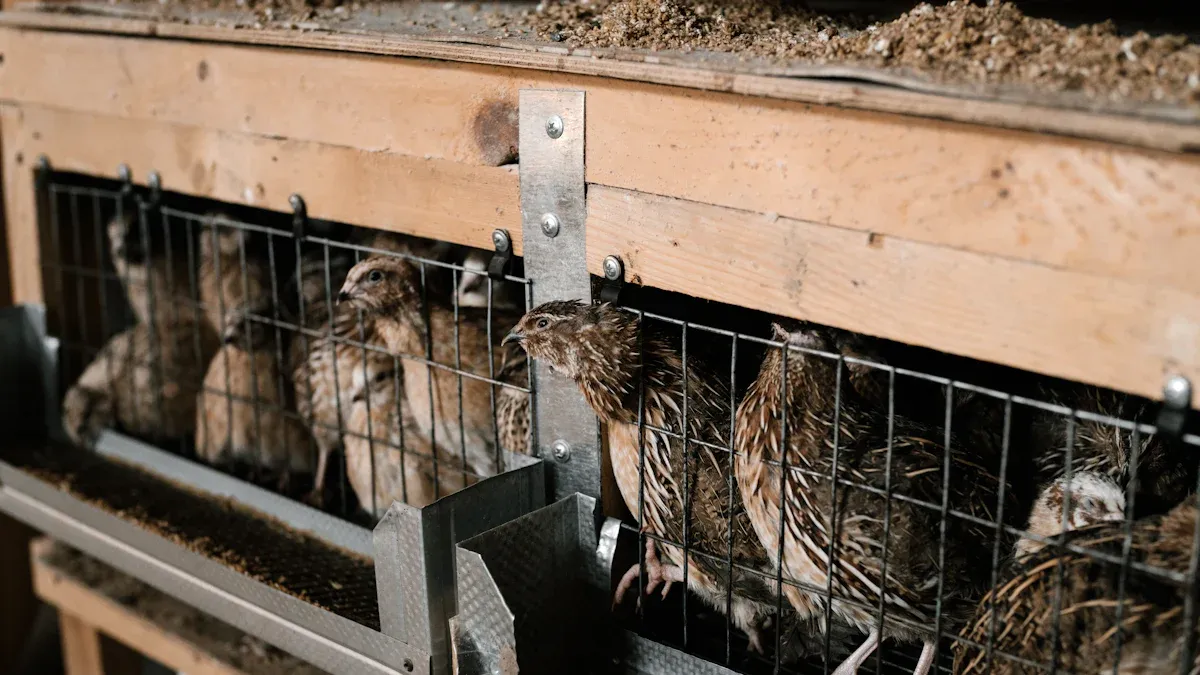
Artificial insemination has revolutionized modern breeding practices, offering breeders unparalleled control over genetic selection and herd improvement. I’ve seen how this technique enhances efficiency and ensures better offspring quality. For instance, studies show that farmers with advanced training and experience achieve higher success rates, while estrus synchronization simplifies herd management and reduces labor costs.
Using the right artificial insemination tools is essential for achieving these benefits. Proper equipment ensures precision, minimizes waste, and maximizes breeding success. Tools like cryogenic storage tanks and insemination guns allow breeders to handle semen effectively and achieve higher pregnancy rates. These advancements make artificial insemination a cornerstone of sustainable and profitable breeding.
Key Takeaways
- Buy good artificial insemination tools to improve breeding success.
- Pick the right artificial vagina to collect better-quality semen safely.
- Use strong, clean semen tubes to avoid germs and keep sperm healthy.
- Choose good semen extenders to protect sperm and stop bacteria growth.
- Use cryogenic tanks to store semen for a long time at very cold temperatures.
- Use insemination guns or pipettes to place semen correctly for better results.
- Use ultrasound machines to check reproductive health and confirm pregnancy.
- Use ovulation detectors to find the best time for insemination and increase chances of pregnancy.
Semen Collection Artificial Insemination Tools

Artificial Vagina (AV)
When it comes to semen collection, I always rely on an artificial vagina (AV) for its efficiency and reliability. This tool mimics the natural environment, ensuring the stallion remains comfortable during the process. Over the years, I’ve noticed that selecting the right AV model can significantly impact the quality of the semen collected. Each model offers unique features tailored to specific needs. Here’s a quick comparison of some popular AV models:
| Model | Features and Benefits |
|---|---|
| Colorado | Retains water temperature longer, durable, cheaper liner replacement, avoids sperm damage from heat shock |
| Missouri | Cheaper, lighter, allows air addition for tighter fit, less direct stimulation preferred by some stallions |
| French (INRA) | Easy to handle, adjustable latex hood for different stallion sizes, less direct stimulation possible |
| BotuPharma | Extremely lightweight, durable, easy to hold, good heat retention properties |
| Roanoke | Lightweight, allows great pressure on glans, short for manual stimulation at sensitive points |
I prefer the Colorado model for its durability and ability to maintain water temperature, which prevents heat shock to the sperm. However, the Missouri model stands out for its lightweight design and affordability, making it a great choice for breeders on a budget. Using an AV also eliminates cross-contamination when collecting from multiple stallions, saving time and extending the lifespan of the latex liner.
Semen Collection Tubes
Semen collection tubes are another indispensable tool in my breeding kit. These tubes ensure the safe transfer and storage of semen after collection. I’ve found that high-quality tubes minimize contamination risks and maintain the viability of the sperm. They come in various sizes and materials, allowing breeders to choose based on their specific requirements.
One of the key advantages of using collection tubes is their convenience. They streamline the process, reducing the time spent transferring semen between containers. Additionally, they are easy to label, which simplifies tracking and organization during artificial insemination procedures. For me, investing in durable and sterile collection tubes has always been a priority. It ensures the success of the entire process, from collection to insemination.
By combining the right AV model with reliable semen collection tubes, breeders can achieve optimal results. These tools form the foundation of any successful artificial insemination program, ensuring precision and efficiency at every step.
Semen Handling and Storage Artificial Insemination Tools
Semen Extenders
Semen extenders play a vital role in preserving sperm quality during storage. I always ensure to use high-quality extenders because they prevent sperm activation and maintain viability. These extenders contain essential salts like potassium, calcium, and sodium, which stabilize the sperm membrane. Buffers such as phosphates and bicarbonates neutralize waste products, ensuring the sperm remains healthy. Additionally, sugars like glucose provide energy and maintain osmotic pressure, which is critical for sperm survival.
In my experience, semen extenders are indispensable for maintaining the integrity of the acrosome and protecting sperm from environmental stress. They also inhibit microbial growth, which could otherwise compromise the semen’s quality. By using the right extender, I can confidently store semen for extended periods without worrying about reduced fertilizing capacity. This tool is a cornerstone of any successful artificial insemination program.
Cryogenic Storage Tanks
Cryogenic storage tanks are another essential component of my artificial insemination toolkit. These tanks are designed to store semen at ultra-low temperatures, typically using liquid nitrogen. I rely on these tanks to preserve semen for long-term use, ensuring its viability remains intact. The tanks’ insulation and durability are critical for maintaining consistent temperatures, which is crucial for preventing sperm damage.
When selecting a cryogenic storage tank, I prioritize capacity and ease of handling. Larger tanks are ideal for storing semen from multiple donors, while smaller tanks are more portable and convenient for fieldwork. Regular maintenance is also essential to ensure the tank’s performance. I always check the liquid nitrogen levels and inspect the seals to avoid temperature fluctuations. These tanks are indispensable for breeders who need reliable storage solutions.
Semen Straws
Semen straws are the final link in the semen handling and storage process. These small, cylindrical containers are used to store and transport semen in precise quantities. I prefer using straws because they are easy to label and organize, which simplifies the insemination process. Their design also minimizes contamination risks, ensuring the semen’s quality remains uncompromised.
In my practice, I use color-coded straws to differentiate between donors, which saves time during insemination. The straws are compatible with most insemination guns, making them versatile and user-friendly. By investing in high-quality semen straws, I can ensure accurate dosing and efficient handling, which are critical for achieving successful breeding outcomes.
Tip: Always store semen straws in cryogenic tanks to maintain their viability and prevent temperature-related damage.
By combining these tools—semen extenders, cryogenic storage tanks, and semen straws—I can handle and store semen with precision and efficiency. These artificial insemination tools are indispensable for any professional breeder aiming for consistent success.
Insemination Artificial Insemination Tools

Insemination Guns or Pipettes
Insemination guns or pipettes are indispensable for precise semen delivery during artificial insemination. I always rely on these tools to ensure accuracy and efficiency. These devices are designed to deposit semen directly into the reproductive tract, maximizing the chances of successful fertilization. Over the years, I’ve noticed that the choice of an insemination gun or pipette can significantly impact the outcome of the procedure.
When selecting an insemination gun, I prioritize compatibility with semen straws and ease of use. For instance, some guns are specifically designed for 0.25 ml or 0.5 ml straws, ensuring a secure fit and smooth operation. Pipettes, on the other hand, are often used for species like pigs, where a different approach is required. I find that using high-quality materials, such as stainless steel or durable plastic, enhances the tool’s longevity and performance.
Tip: Always sterilize insemination guns or pipettes before and after use to prevent contamination and ensure optimal results.
Speculums
Speculums are another critical tool in my artificial insemination kit. These devices allow me to visualize the reproductive tract, ensuring accurate semen placement. I’ve found that using a speculum not only improves precision but also reduces the risk of injury to the animal. They come in various sizes and designs, catering to different species and breeding requirements.
For example, I prefer illuminated speculums for their built-in light source, which enhances visibility during the procedure. Disposable speculums are also a great option for maintaining hygiene, especially when working with multiple animals. By choosing the right speculum, I can perform the insemination process with greater confidence and efficiency.
Lubricants
Lubricants play a vital role in facilitating smooth and comfortable insemination procedures. I always use a high-quality, non-spermicidal lubricant to minimize friction and prevent damage to the reproductive tract. These lubricants ensure that the insemination tools glide effortlessly, reducing stress for the animal and improving the overall experience.
In my practice, I’ve noticed that the right lubricant can make a significant difference in the success of the procedure. For instance, water-based lubricants are ideal because they are gentle and easy to clean. I avoid oil-based products, as they can interfere with sperm viability. Proper application of lubricant not only enhances the efficiency of the process but also demonstrates a commitment to animal welfare.
By combining these tools—insemination guns or pipettes, speculums, and lubricants—I can perform artificial insemination with precision and care. These tools are essential for any breeder aiming to achieve consistent and successful outcomes.
Monitoring and Diagnostic Artificial Insemination Tools
Ultrasound Machines
Ultrasound machines are indispensable for monitoring reproductive health and ensuring the success of artificial insemination procedures. I rely on these devices to visualize the reproductive tract and confirm pregnancy with precision. They provide real-time imaging, which allows me to assess the condition of the uterus and ovaries. This information is critical for determining the optimal timing for insemination.
When choosing an ultrasound machine, I prioritize portability and image quality. Portable models are ideal for fieldwork, as they are lightweight and easy to handle. High-resolution imaging ensures I can detect even the smallest abnormalities. For example, I use a machine with Doppler capabilities to monitor blood flow, which helps me evaluate ovarian activity. This feature has proven invaluable in improving breeding outcomes.
Tip: Regularly calibrate your ultrasound machine to maintain accuracy and extend its lifespan.
In my experience, ultrasound machines also enhance animal welfare. By using non-invasive imaging, I can minimize stress and discomfort for the animals. This approach not only improves the success rate of artificial insemination but also demonstrates a commitment to ethical breeding practices.
Ovulation Detectors
Ovulation detectors are another essential tool in my breeding toolkit. These devices help me pinpoint the exact moment of ovulation, which is crucial for timing artificial insemination. Accurate timing ensures the sperm meets the egg at the optimal stage, maximizing the chances of conception.
I prefer ovulation detectors that use bioelectrical impedance technology. These devices measure changes in the animal’s cervical mucus, which correlate with hormonal fluctuations during the estrous cycle. Handheld models are particularly convenient, as they are easy to use and provide quick results. For larger operations, I recommend automated systems that can monitor multiple animals simultaneously.
Using ovulation detectors has significantly improved my breeding efficiency. They reduce the guesswork involved in estrus detection, saving time and resources. Additionally, these tools allow me to identify animals with irregular cycles, enabling targeted interventions to address fertility issues.
Note: Always clean and sterilize ovulation detectors after each use to prevent cross-contamination.
By incorporating ultrasound machines and ovulation detectors into my practice, I can monitor reproductive health with greater accuracy. These artificial insemination tools not only enhance efficiency but also contribute to better breeding outcomes. They are indispensable for any professional breeder committed to achieving consistent success.
Investing in high-quality artificial insemination tools is essential for achieving consistent breeding success. These tools enhance efficiency and accuracy, allowing breeders to improve genetic selection and herd health. I’ve seen firsthand how better equipment leads to higher pregnancy rates and healthier offspring.
The economic benefits are undeniable:
- Increased dairy production through improved genetics boosts profit margins.
- Reduced calving difficulties lower costs associated with calf distress.
- Crossbreeding introduces profitable traits, expanding market opportunities.
Upgrading equipment also ensures proper semen handling, which is critical for success. Farmers with advanced training and modern tools consistently achieve better results. By evaluating and upgrading your artificial insemination tools, you can stay competitive and meet evolving market demands.
FAQ
What is the most important tool for artificial insemination?
The most critical tool depends on the stage of the process. For semen collection, I recommend an artificial vagina. During insemination, insemination guns or pipettes are indispensable for precise semen delivery.
How do I choose the right cryogenic storage tank?
I always consider capacity, portability, and insulation quality. Larger tanks suit long-term storage, while smaller ones are ideal for fieldwork. Regular maintenance ensures consistent performance.
Can I reuse semen straws?
No, semen straws are single-use to prevent contamination and ensure semen quality. I always use new, sterile straws for every procedure to maintain hygiene and accuracy.
How do I clean insemination tools?
I sterilize all tools before and after use. For metal tools, I use an autoclave or chemical disinfectant. Disposable tools, like speculums, simplify hygiene management.
What is the role of semen extenders?
Semen extenders preserve sperm viability during storage. They provide essential nutrients, stabilize membranes, and prevent microbial growth. I rely on high-quality extenders to maintain semen integrity.
Are ultrasound machines necessary for artificial insemination?
Yes, ultrasound machines are essential for monitoring reproductive health and confirming pregnancy. I use them to determine the optimal insemination timing and improve breeding outcomes.
How do ovulation detectors work?
Ovulation detectors measure changes in cervical mucus or bioelectrical impedance. These changes indicate hormonal fluctuations. I use them to pinpoint ovulation timing and maximize conception rates.
What lubricant should I use for insemination?
I recommend a water-based, non-spermicidal lubricant. It minimizes friction and protects the reproductive tract. Avoid oil-based products as they can harm sperm viability.
Tip: Always check the lubricant’s compatibility with your tools and procedures for optimal results.
Post time: Mar-04-2025
